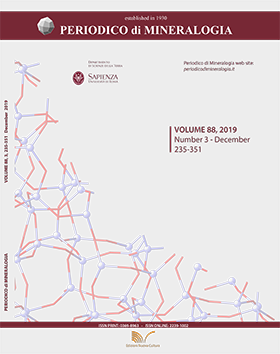Nature of the Tourmaline Formation in Quartz porphyry in the E Sakarya Zone (NE Turkey): Geochemistry and Isotopic Approach
DOI:
https://doi.org/10.2451/2019PM859Keywords:
Geochemistry, O- and H- isotopes, quartz porphyry, tourmaline, Karadağ, Eastern Pontide, TurkeyAbstract
Tourmaline, which exhibits important differences in terms of texture and composition, is found in 44 My aged quartz porphyry from Karadağ in the eastern Pontide (NE Turkey). Tourmaline has high Al and Mg contents and is the chemical zoning; it contains Mg that can substitute for Fe and/or Al in the Y site and X-vacancy that can replace Na in the X site from the core to rim. Tourmaline, classified as dravite component, has low Fe content and very low Ca content. The V (112–510 ppm) and Sr (37.3–147.1 ppm) contents of tourmalines related to quartz porphyry are in conformity with metamorphic and magmatic tourmalines. Tourmalines have similar rare earth elements (REEs) but lower heavy REE contents than host quartz porphyry. The δ18O and δD values of tourmalines are relatively narrow, ranging from 5.7 to 8.5‰ V-SMOW and from -58 to -72‰ V-SMOW, respectively, consistent with primary magmatic water. The oxygen–isotope thermometry calculation of quartz and tourmaline pair yields equilibrium formation temperature of 432 °C. The formation of tourmaline shows a post magmatic origin, confirming magmatic fluid cooling and fluid–rock interactions.Downloads
Published
2019-12-02
Issue
Section
MINERALOGY and CRYSTALLOGRAPHY


